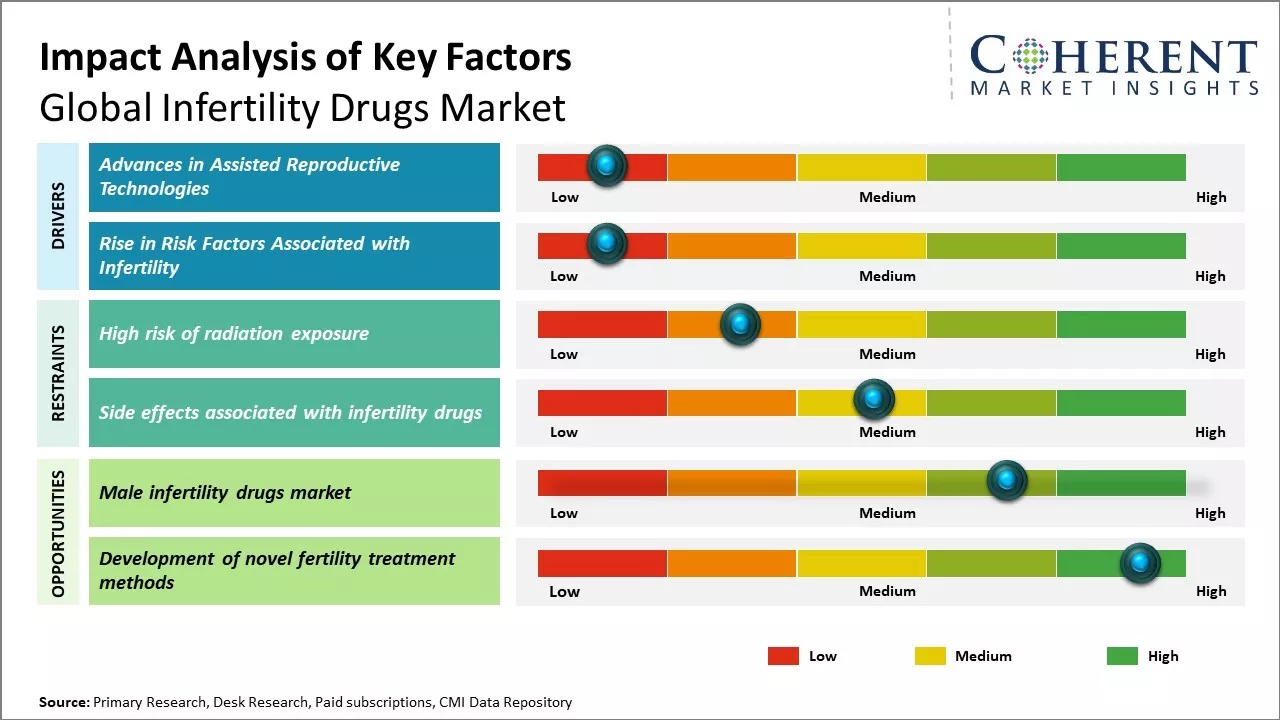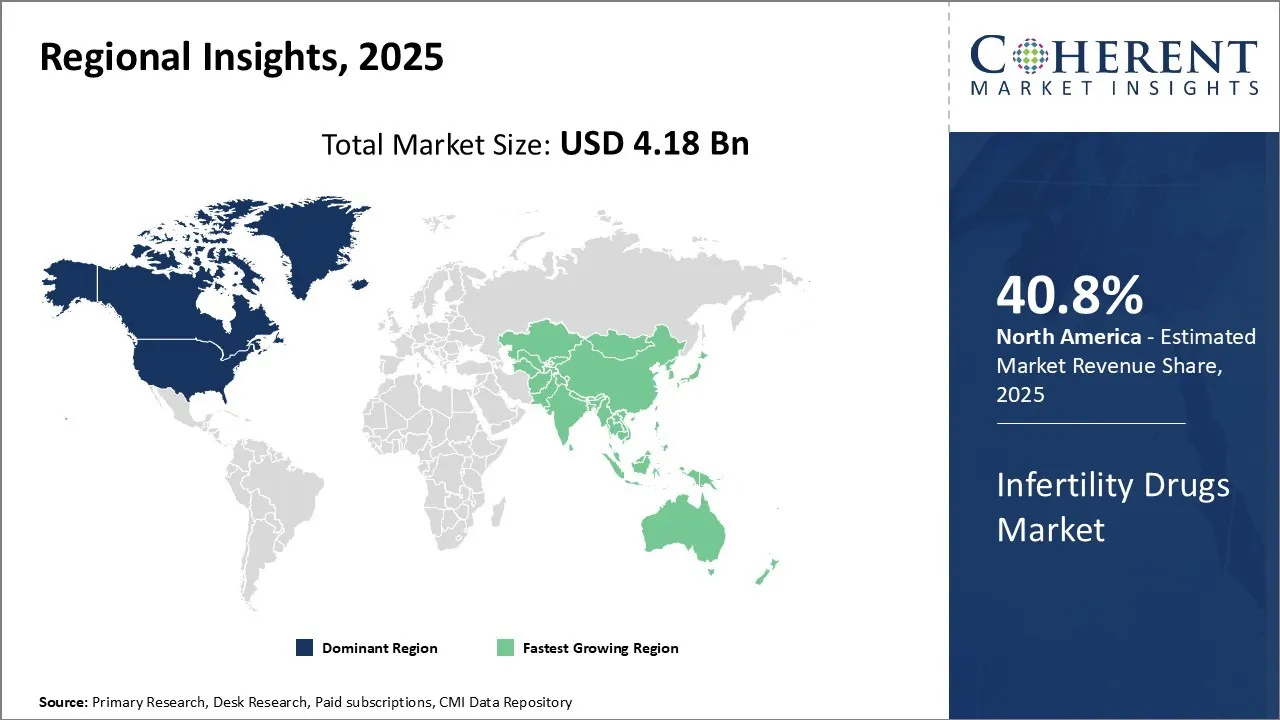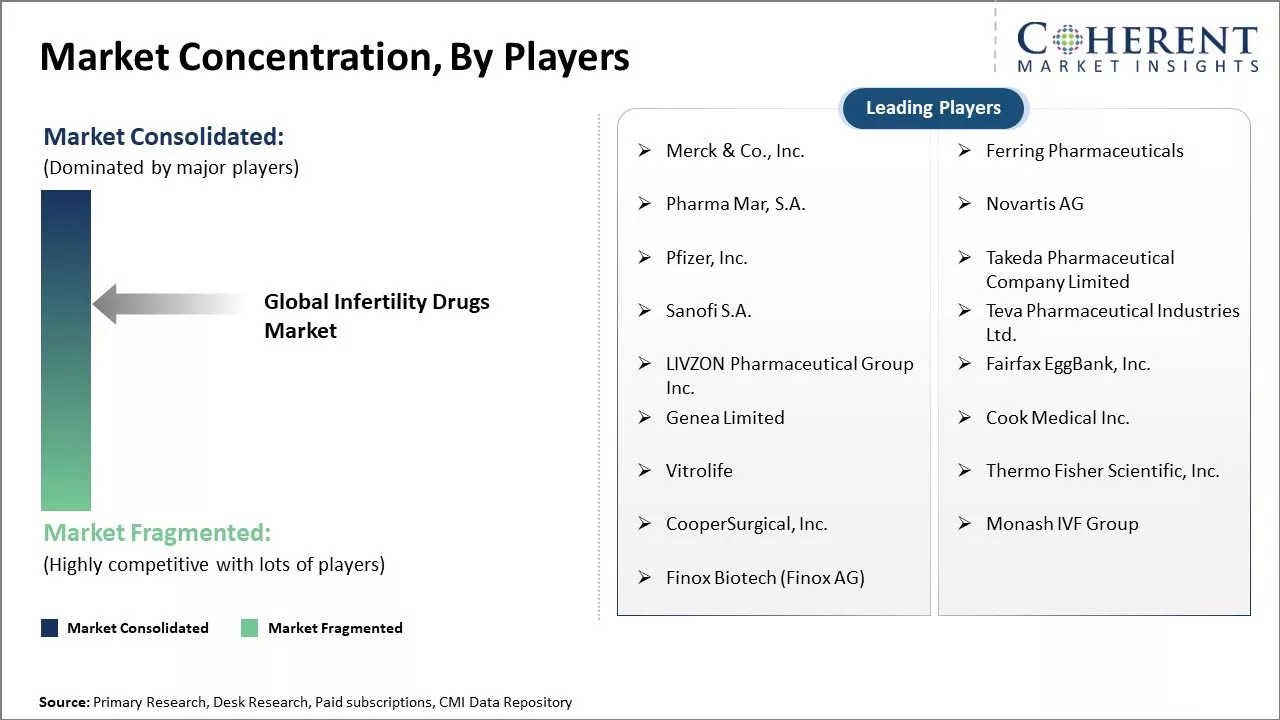Global infertility drugs market is estimated to be valued at USD 4.18 Bn in 2025 and is expected to reach USD 6.62 Bn by 2032, exhibiting a compound annual growth rate (CAGR) of 6.8% from 2025 to 2032.

To learn more about this report, Download Free Sample
Increasing prevalence of infertility issues due to lifestyle changes, rising stress levels, and obesity can drive the global infertility drugs market. Rising healthcare expenditure, growing awareness regarding infertility treatments, technological advancements in fertility treatment techniques, and availability of reimbursement coverage for fertility treatments in developed countries can boost infertility drugs market demand.
|
Current Events |
Description and its impact |
|
Geopolitical Factors and International Trade Environment |
|
|
Demographic Changes and Regional Fertility Trends |
|
|
Global Economic Downturn and Inflationary Pressure |
|
Uncover macros and micros vetted on 75+ parameters: Get instant access to report
Artificial Intelligence (AI) is significantly transforming the infertility drugs market by enhancing drug development processes, personalizing treatment protocols, and improving clinical outcomes. In November 2024, SpOvum launched ARTGPT, an AI-powered platform designed to transform patient interaction in assisted reproductive technology (ART). Using natural language processing, ARTGPT delivers instant, personalized, and fact-based responses 24/7 by accessing reliable ART and infertility medical guides.
The reimbursement landscape for infertility drugs varies significantly across regions, impacting market accessibility and affordability. In countries like the United States, some private insurers cover infertility drugs partially, often limiting coverage to specific patient groups or treatment cycles, which restricts market demand. For instance, Parliament has approved the reinstatement of Kela reimbursement for fertility treatments provided by private healthcare providers. This amendment will take effect on May 1, 2025, with the goal of supporting individuals and couples facing medical infertility challenges. Also, Merck, a prominent science and technology company, launched a comprehensive Fertility Benefit program in October 2023, providing employees with financial assistance for fertility treatments. The program will roll out in eight countries: Germany, the United Kingdom, Switzerland, China, India, Taiwan, Brazil, and Mexico. Merck already offers similar benefits to employees in the United States, Canada, and Japan.
In terms of drug type, the gonadotropins segment is projected to hold the highest market share of 25.5% in 2025, driven by its proven clinical effectiveness in infertility treatment. Gonadotropins, which include follicle-stimulating hormone (FSH) and luteinizing hormone (LH), stimulate ovarian follicle development and are critical in assisted reproductive technology (ART) procedures like in-vitro fertilization (IVF). These drugs enable the retrieval of multiple high-quality eggs in one cycle, enhancing embryo quality and pregnancy rates. Their standardized formulation, reliability, and minimal invasiveness make them preferred by both clinicians and patients. Growing global IVF success rates have fueled demand from fertility clinics. For instance, Turkiye has urged the Indian government to supply gonadotropin drugs to support its reproductive health sector, indicating rising international demand and confidence in the drug’s efficacy.
In 2025, the oral segment is projected to hold the highest market share of 71.5%, largely due to its convenience over parenteral drugs. Oral medications allow for self-administration without the need for injections or clinic visits, offering greater comfort and discretion to patients. For instance, clomiphene citrate and letrozole are widely used oral drugs in infertility treatment, particularly for conditions like PCOS and unexplained infertility. These options are effective, non-invasive, and well-absorbed, making them ideal first-line therapies. Additionally, oral administration improves patient compliance and simplifies clinical monitoring. As noted in pharmacological reviews, oral routes are preferred for their ease and self-sufficiency compared to injectables. The rise of telehealth has further accelerated adoption of oral infertility treatments through remote consultations and prescriptions.
In terms of gender, the female segment is estimated to contribute the highest market share of 70.5% in 2025, largely driven by entrenched socio-cultural norms across various regions. For instance, in many traditional and developing societies, fertility is predominantly seen as a woman’s responsibility, leading women to be the first to seek medical help when conception is delayed. Social stigma around sub-fertility often impacts women more heavily than men, propelling females to pursue treatments earlier to demonstrate fertility and avoid criticism within their communities. While family planning has shifted childbearing age, societal expectations for motherhood remain strong, increasing pressure on women’s natural fertility.

To learn more about this report, Download Free Sample
North America continues to lead the global infertility drugs market, with an estimated market share of 40.8% in 2025. This dominance is primarily driven by the United States, where the presence of major pharmaceutical companies and widespread adoption of assisted reproductive technologies (ART) such as in vitro fertilization (IVF) contribute significantly to market growth. A notable advancement in the region is the birth of the world's first baby conceived through an automated IVF procedure. Engineers and embryologists in New York remotely operated robots in Mexico to perform intracytoplasmic sperm injection (ICSI), a form of IVF, resulting in a successful live birth. This milestone demonstrates the potential of automation to standardize complex fertilization procedures and could enhance the success rates of certain IVF methods in the future. Additionally, the availability of advanced fertility treatments and rising public awareness about infertility issues drive infertility drugs market growth across the region. Favorable reimbursement policies for infertility drugs and procedures further support access to treatments. The increasing acceptance of ART and continuous innovation in drug formulations are expected to sustain and propel infertility drugs industry growth.
Asia Pacific is poised to register the fastest growth in the global infertility drugs market. Countries like China and India are emerging as highly lucrative markets, driven by rapid economic development, rising healthcare expenditure, and increasing infertility rates linked to lifestyle changes and delayed pregnancies. For instance, Mankind Pharma has introduced generic Dydrogesterone tablets in the Indian market, intended for treating infertility and pregnancy-related complications. The region also benefits from growing medical tourism, as patients seek cost-effective yet advanced fertility care. This is further positively influencing the infertility drugs market forecast.
India’s infertility drug market is witnessing rapid growth, driven by increasing infertility rates and rising awareness among the population. The expanding adoption of assisted reproductive technologies (ART) such as in vitro fertilization (IVF) has played a significant role in fueling this growth. Affordable fertility treatments offered by hospitals like SAT Hospital in Kerala have made parenthood more accessible for many couples who previously could not afford such procedures.
Additionally, the emergence of femtech startups like Arva Health, which recently secured USD 1 million in pre-seed funding, is transforming fertility care in India by integrating digital health solutions with clinical services. Government initiatives aimed at making infertility treatments more accessible and affordable further support market expansion. The combination of improved treatment availability, technological innovation, and growing social acceptance of ART is expected to sustain strong demand for infertility drugs in India over the coming years.
China also has one of the world’s highest rates of infertility, affecting married couples of childbearing ages, according to data cited in the article. In China, infertility affected 25% of couples of reproductive ages. This statistic alone underscores the enormous potential for infertility drugs in the Chinese market. The rise in infertility has been partially attributed to delayed marriage, increased urban stress, environmental pollutants, and lifestyle factors such as smoking and obesity all of which require clinical intervention. China’s infertility drugs market is on a trajectory of sustained growth, backed by demographic urgency and policy realignment. But to unlock full potential, the country must address cost, access, and regulatory clarity. The ongoing transformation of China's reproductive health infrastructure presents both a critical challenge and a lucrative opportunity for domestic and global pharmaceutical players.

To learn more about this report, Download Free Sample
| Report Coverage | Details | ||
|---|---|---|---|
| Base Year: | 2024 | Market Size in 2025: | USD 4.18 Bn |
| Historical Data for: | 2020 To 2024 | Forecast Period: | 2025 To 2032 |
| Forecast Period 2025 to 2032 CAGR: | 6.8% | 2032 Value Projection: | USD 6.62 Bn |
| Geographies covered: |
|
||
| Segments covered: |
|
||
| Companies covered: |
Merck & Co., Inc., Ferring Pharmaceuticals, Pharma Mar, S.A., Novartis AG, Pfizer, Inc., Takeda Pharmaceutical Company Limited, Sanofi S.A., Teva Pharmaceutical Industries Ltd., LIVZON Pharmaceutical Group Inc., Fairfax EggBank, Inc., Genea Limited, Cook Medical Inc., Vitrolife, Thermo Fisher Scientific, Inc., CooperSurgical, Inc., Monash IVF Group, Finox Biotech (Finox AG) |
||
| Growth Drivers: |
|
||
| Restraints & Challenges: |
|
||
Uncover macros and micros vetted on 75+ parameters: Get instant access to report
In recent years, there have been significant advancements in assisted reproductive technologies for treating infertility issues. Technologies such as IVF, ICSI, and surrogacy have enabled many couples to fulfill their dreams of having children. Success rates of IVF cycles have improved due to better understanding of human reproductive biology as well as refinements in laboratory procedures. Furthermore, egg freezing has emerged as a viable option for women looking to delay pregnancy but preserve their fertility. This has especially benefited women focusing on their careers. The availability of these technologies in standard fertility clinics and IVF centers across major cities has made them accessible to more people.
Growing demand for these technologies can boost need for infertility drugs that help stimulate egg production, facilitate sperm collection, prepare the endometrium, and support early pregnancy. New drugs that specifically target underlying causes of infertility are also entering the market. The continuous technological breakthroughs in this area and rising ability to pay for them in developing markets can boosts use of related fertility medications.
Various lifestyle and environmental factors contribute to risk factors linked with infertility. Delayed childbearing driven by social and economic reasons has increased the chances of age-related infertility in women. Furthermore, triple health burden of obesity, diabetes, and hypertension can also negatively impact fertility and make conception difficult. Changing dietary patterns have also altered hormonal balances in both men and women. Exposure to toxins and chemicals through polluted air and water as well as certain occupational hazards are raising concerns about their effects on reproductive health. The resultant stresses on reproductive systems signal a growing need for medical assistance. This makes infertility drugs an increasingly important component of the initial evaluation and treatment process.
The male infertility drugs market holds much promise within the global infertility drugs market. Infertility rates have been rising steadily due to trending lifestyles and environmental factors. According to the World Health Organization, around 9% of men globally experience some form of infertility. The stresses of modern life combined with other issues like rising obesity, alcohol/tobacco use and genetic abnormalities have all contributed to increasing male factor infertility. As social attitudes change and seeking treatment for fertility issues becomes less stigmatized, more men are likely to seek help.
Advanced age of first-time fathers has also played a role as sperm quality naturally declines with increasing age. With delayed childbearing becoming more common, there has been huge need for effective medical assistance to treat male infertility. Growing medicalization of reproduction signals boosts demand for prescription solutions like testosterone booster, selective estrogen receptor modulators and aromatase inhibitors that are used to treat conditions like low sperm counts or poor motility/morphology.
*Definition: Global infertility drugs market consists of pharmaceutical drugs that are used to treat infertility and related medical conditions. These drugs help stimulate ovulation, increase sperm production, or aid in sperm function and transport. Some common infertility drugs include clomiphene citrate, letrozole, and gonadotropins which are taken orally or administered via intramuscular injections. The global infertility drugs market has been growing in recent years due to rising infertility rates around the world as well as increasing social acceptance and awareness of assisted reproductive technologies.
Share
Share
About Author
Ghanshyam Shrivastava - With over 20 years of experience in the management consulting and research, Ghanshyam Shrivastava serves as a Principal Consultant, bringing extensive expertise in biologics and biosimilars. His primary expertise lies in areas such as market entry and expansion strategy, competitive intelligence, and strategic transformation across diversified portfolio of various drugs used for different therapeutic category and APIs. He excels at identifying key challenges faced by clients and providing robust solutions to enhance their strategic decision-making capabilities. His comprehensive understanding of the market ensures valuable contributions to research reports and business decisions.
Ghanshyam is a sought-after speaker at industry conferences and contributes to various publications on pharma industry.
Missing comfort of reading report in your local language? Find your preferred language :
Transform your Strategy with Exclusive Trending Reports :
Frequently Asked Questions
Joining thousands of companies around the world committed to making the Excellent Business Solutions.
View All Our Clients